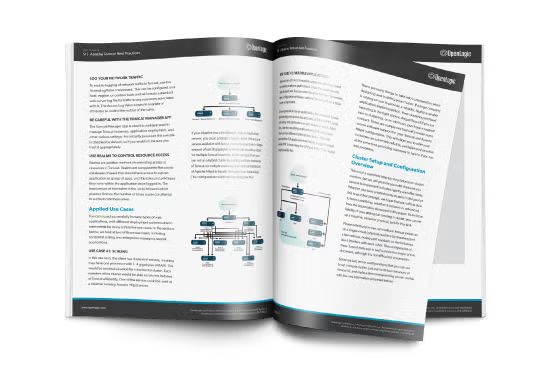Blog
April 29, 2025
After nearly two years in development, Apache Tomcat 11 is finally here and stable enough for production. This is a long anticipated release, as it's the first major version of Tomcat to come out since 10.1 at the end of 2020.
In this blog, find out what's new in Tomcat 11, how it compares to Tomcat 10, and what teams should consider before upgrading their application servers to the latest specifications.
About Apache Tomcat 11
Tomcat 11 implements the Servlet 6.1, Java Server Pages 4.0, Expressional Language 6.0, WebSocket 2.2 and Authentication 3.1 specifications which are required by the Jakarta EE 11 platform. The release will run on JDK 17+, but additional features can be unlocked by running a more recent release of the JDK.
A little background on the project: Apache Tomcat has been a dominant open source Java-based application server since its inception 26 years ago. According to the 2025 Java Developer Productivity Report produced by Perforce JRebel, 70% of Java developers use Tomcat as their application server. In 2005, it became a top-level Apache project between the releases of Tomcat 5.5 and Tomcat 6. Last year Tomcat celebrated its 25th anniversary since its first commit and ninth major release as an Apache Software Foundation project. Major Tomcat versions come out typically every three years and the support lifecycle is usually 10 years, with version 8.5 becoming end of life in March of 2024.
Tomcat 11 Release Date
Apache Tomcat 11.0 was announced on October 9, 2024. However, a release is not considered stable until the Java specifications it implements have been finalized. In the case of Tomcat 11, this occurred when the Jakarta EE release review completed on April 7, 2025. Tomcat 11.0.6, the stable release, came out two days later on April 9, 2025.
As noted above, Tomcat 11 is in its sixth minor point release, and there are some interesting changes for users taking their current application servers to the latest specifications.
Back to topOn-Demand Webinar: Taming Tomcat 11
OpenLogic and JRebel experts explore the latest release, sharing tips for Java teams on how to accelerate feature adoption and plan their upgrades.
Tomcat 11 Features and Changes
The most notable change in Tomcat 11 is the addition of virtual thread support provided by Project Loom (JEP 444) which brings “easy-to-use, high-throughput, lightweight concurrency” that is managed by the Java Runtime Environment. This is an alternative to Tomcat’s standard thread pool which allocates platform and operating system kernel threads. JDK 21+ is required for virtual thread support.
You no longer have to restart Tomcat to reload TLS keys and certificates as this is done automatically with zero downtime. You can integrate with a provider like LetsEncrypt to simplify the process to renew TLS certificates.
You also can now use OpenSSL for TLS via Java’s new Foreign Function and Memory (FFM) API (part of Project Panama) which simplifies integrating Tomcat with OpenSSL. Java Native Interface (JNI) was the previous bridge between Java and foreign libraries which was cumbersome and difficult to use. Project Panama is a standard feature starting in Java 22, and it will be easier to access with the next Java LTS as users become more confident about deploying a JVM that supports the API. The next Java LTS version will be Java 25, which is slated to be released in September of 2025.
There were plans to add HTTP/3 over Quick UDP Internet Connections (QUIC) protocol, but these plans appear to be shelved at the moment due to demand for the feature. QUIC is responsible for performing TLS encryption and decryption which is a CPU intensive process. It is best practice to have reverse proxy on a separate machine for TLS termination such as NGINX in front of Tomcat, so that Tomcat dedicates CPU cycles to focus primarily on application logic. If QUIC were to be implemented on Tomcat in the future, then it would use Java’s Project Panama and a native QUIC stack.
Java 17 (and later) will be the supported versions of Tomcat 11, which is a significant jump from Java 11+ in Tomcat 10.1 and Java 8 in Tomcat 10.0.
Back to topThe Enterprise Guide to Apache Tomcat
In this free guide, our team of Tomcat experts discusses the key strategies enterprises can employ to improve their Tomcat deployments, with detailed analysis and examples to help guide the way.
Tomcat 10 vs. Tomcat 11
The main difference between Tomcat 10 vs. Tomcat 11 is that Tomcat 11 takes advantage of the new specifications and JDK features, making it a smaller jump between versions — less significant than, for example, the one between Tomcat 9 and Tomcat 10.
Tomcat 10.1 implements the Servlet 6.0, JSP 3.1, EL 5.0, WebSocket 2.1 and Authentication 3.0 specifications that are required by Jakarta EE 10. Tomcat 11 will include the latest versions of specifications like Jakarta Servlet 6.1, Jakarta Server Pages 4.0, Jakarta Expression Language 6.0, Java WebSocket, Jakarta Authentication, and Jakarta Annotations in Jakarta EE 11. The Jakarta specification changes between versions 10 and 11 are mostly about clarifying gray areas, small feature improvements, and addressing technical debt.
Back to topTomcat 11 Upgrade Considerations
Due to the migration from Java EE to Jakarta EE as part of the move to the Eclipse Foundation, the package names for the implementation API were changed from javax.* to jakarta.*. This change started in Tomcat 10.0. Any code written using the pre-Tomcat 10 API will require changes before moving to this release. If you are already on Tomcat 10.x, then this change will not affect you. Tomcat 10.0 and 10.1 implemented the specifications in Jakarta EE 9 and 10, respectively.
Read more about how to upgrade Tomcat >>
Back to topWhat to Expect from Future Tomcat 11.x Releases
The current focus is addressing any defects and security vulnerabilities. There have been a few CVEs discovered in this release which have been addressed. It is recommended to run the latest minor point version that will include patches for these vulnerabilities.
Part of declaring a major release stable depends on the judgment of the core committers to the project. Previous major versions of Tomcat releases had significantly different code bases, and a window was given to allow time for bugs to be found before declaring a major release stable. This will change going forward as future releases will attempt to keep the code base more in-line and reduce differences between releases. This will give people a greater degree of confidence in code, and therefore, in the stability of future releases.
Back to topLooking Ahead to Tomcat 12
Development on Apache Tomcat 12 is currently in progress. Currently, there are not enough specific features to start milestone releases, but this will change in the next month or two. You can view the current change log here.
You will see sections for Tomcat’s individual components such as Catalina, Coyote, Jasper, Cluster, WebSocket, Web applications, Extras, Tribes, and jdbc-pool. Any items above the lines that say “backport and removal” are features specific to version 12.0.x. The minimum JDK requirement will be version 21 for Tomcat 12.
The focus on the 12.0.x will be to implement the Jakarta EE 12 updates for Servlet, Pages, EL, and WebSocket.
Back to topFinal Thoughts
Major Tomcat releases are supported by the community for ten years, so upgrading to the latest and greatest version may not feel all that urgent. However, upgrades offer many benefits in terms of new features and improved performance, and running the most current version of Tomcat is also the best way to avoid being exposed to vulnerabilities. As always, make sure you have a proper test environment set up whenever you are planning to upgrade or migrate.
To keep up with the latest updates to Tomcat 11, follow the release milestones in the changelog. The community is always open to suggestions, so if there are features you would like to see added, make your voice heard!
Need Help With Tomcat Tuning or Configuration?
OpenLogic can support your Tomcat deployments and assist you with performance tuning, configuration, security, and more. Click the button below to learn more or connect with one of our Tomcat experts.
Additional Resources
- Blog - A Guide to Application Logging in Tomcat
- Blog - Troubleshooting Tomcat Errors
- On-Demand Webinar - Modernizing Your Java Applications With Open Source
- Datasheet - Support and Services for Apache Tomcat
- Blog - Apache Tomcat 10
- Blog - Tomcat Configuration Tips and Tricks
- Blog - 5 Apache Tomcat Performance Best Practices
- Guide - Apache Tomcat Overview

